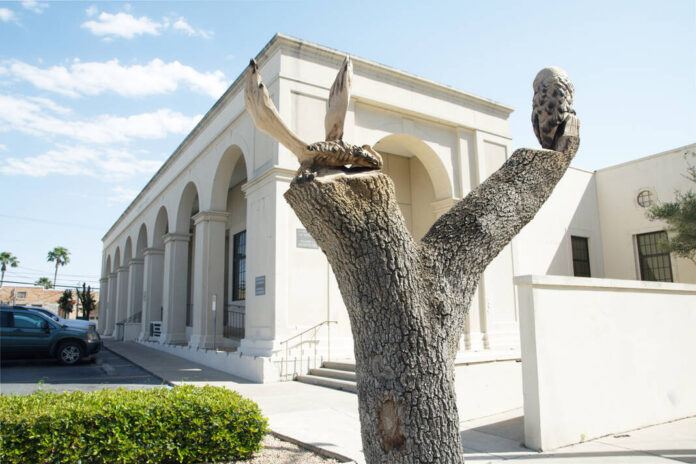
This dead live oak tree in front of the U.S. Post Office at 221 E. Van Buren Ave. is the first of three such commissioned art projects in the downtown district. Carved by sculptor Andy Hancock, the tree now is adorned by an owl at the right and an osprey clutching a fish at the left. (Rick Kelley/Valley Morning Star)
HARLINGEN — Just look at it as saving a tree from the smoke pit.
Artist Andy Hancock was commissioned by the City of Harlingen to turn a dead tree into art, and instead of a brush and canvas, he does it with a chainsaw and angle grinder.
“My tools of choice. You evolve a style and that’s where mine comes from, because I’ve worked outside my whole career,” Hancock said. “Very rarely do I do gallery work.”
For 30 years Hancock has been producing his outside art, much of it public art, and he is well-known for his sand castle sculptures on South Padre Island as well as his wood sculpture and chainsaw art.
In fact, one of his most impressive works is the carved, nearly eight-foot-long sea turtle now on display in front of Sea Ranch Restaurant on the Island. Other works include the Sea Ranch Dolphins, the Hilton Tikis and the Ramada Castle.
Now he’s working to “resurrect” one of three trees in Harlingen by turning dead trunks into living sculpture as part of a restoration effort by the Downtown Development District.
Hancock’s project, the first, was the live oak tree in front of the U.S. Post Office on East Van BurenAvenue, which is now transformed into an owl and an osprey clutching a fish. Lower in the tree trunk is an embossed owl face, appearing to be looking out from a nesting hole, at “kid height,” Hancock says.
“I was involved in many large-scale projects, like the Harlingen downtown one, but on a bigger scale as far as sculpture went,” Hancock said. “But basically there’d be trees on a site somewhere and the community didn’t want them taken down, and you’d end up with a project where the community was quite vociferous in some cases about what they wanted.
“Well the only way to bridge that gap is to communicate,” he added. “And you have to communicate that they’re not going to lose their tree, they’re going to enjoy it for the rest of its life.”
Hancock has titled his tree on East Van Buren “Birds of the Valley.” Each of the three tree projects will be commissioned via $600 grants to the artists.
“You just let them discover it, and the discovery for the public is what makes public art work,” Hancock said. “You can tell people to ‘yes, go and see something,’ but there’s nothing nicer than walking around a corner and seeing something that you love and go ‘Wow, look at that, that’s cool!’”




